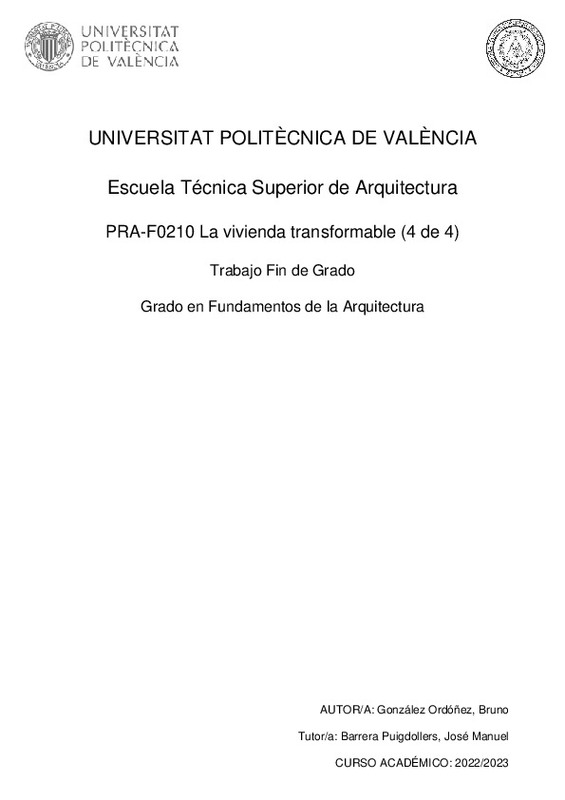|
Resumen:
|
[ES] La sociedad actual ha sufrido importantes cambios a lo largo del tiempo desde el punto de vista económico, político, social, tecnológico, cultural y climático. Este hecho se evidencia principalmente desde finales del ...[+]
[ES] La sociedad actual ha sufrido importantes cambios a lo largo del tiempo desde el punto de vista económico, político, social, tecnológico, cultural y climático. Este hecho se evidencia principalmente desde finales del siglo XX y ha significado un cambio total de paradigma que ha modificado la composición familiar habitual, lo que, a su vez, ha alterado las formas tradicionales de habitar un hogar. El diseño rígido característico de la mayoría de los proyectos habitacionales de hoy en día, no reflejan ni se adaptan a las necesidades cambiantes del usuario, derivando en la obsolescencia de la vivienda. Es por ello que la arquitectura ha realizado notables esfuerzos para responder con diseños que se ajusten en lo posible a los cambios internos y externos a lo largo de su vida útil, ya que han sido pensadas para permanecer un largo periodo de tiempo. Esta modalidad de diseño se conoce como arquitectura transformable.
En este trabajo se analizará el papel de la arquitectura transformable en la evolución de la flexibilidad enfocada en la vivienda mediante la recopilación y estudio de diversos ejemplos de edificaciones y viviendas flexibles, contrastando como sus respectivos arquitectos emplearon diversos mecanismos para ejecutar diseños funcionales, con criterios de sostenibilidad, calidad, economía, colectividad, industrialización e, incluso, emocionalidad. Este último, mediante el empleo de ciertos materiales o colores para lograr conectividad del usuario con el exterior o para jugar con la intensidad de la luz y sus variaciones cromáticas y modificar por completo el espacio de acuerdo al estado de ánimo del usuario. Esta nueva tendencia está revolucionando la arquitectura transformable moderna. Para la mayoría de los ejemplos estudiados, el enfoque de ¿Open Building¿ ha sido esencial para lograr el éxito a largo plazo, ya que permite la adaptación del espacio, tanto en forma como en tamaño y uso, de acuerdo a las necesidades el usuario. En general, la arquitectura transformable tiene como propósito otorgarle al habitante el poder de ser ¿el arquitecto de su propio hogar¿, de allí la necesidad de aplicarla en el diseño de viviendas colectivas y evitar la estandarización.
[-]
[EN] Current society has undergone important changes over time from the economic, political, social, technological, cultural and climate point of view. This fact is evidenced mainly since the end of the 20th century and ...[+]
[EN] Current society has undergone important changes over time from the economic, political, social, technological, cultural and climate point of view. This fact is evidenced mainly since the end of the 20th century and has meant a total paradigm shift that has modified the usual family composition, which, in turn, has altered the traditional ways of living at home. The characteristic rigid design of most today's housing projects, do not reflect or adapt to user's changing needs, deriving in the obsolescence of the house. That is why architecture has made notable efforts to respond with designs that adjust as much as possible to internal and external changes throughout its useful life, since they have been thought to remain a long period of time. This design modality is known as transformable architecture.
This work will analyze the role of architecture transformable in the evolution of flexibility focused on housing through the collection and study of various examples of flexible buildings and homes, contrasting as their respective architects used various mechanisms to execute functional designs, with criteria of sustainability, quality, economy, collectivity, industrialization and even, emotionality. The latter, by using certain materials or colors to achieve user connectivity with the outside or to play with the intensity of the light and its chromatic variations and completely modify the space according to the user's mood. This new trend is revolutionizing modern transformable architecture. For most of the examples studied, the ¿Open Building¿ approach has been essential to achieve long -term success, since it allows the adaptation of space, both in form and in size and use, according to the needs of the user. In general, the transformable architecture aims to grant the inhabitant the power to be ¿the architect of his own home¿, hence the need to apply it in the design of collective homes and avoid standardization.
[-]
|







